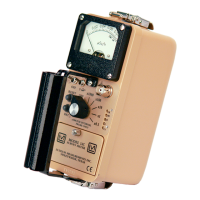Model 14C Survey Meter
Ludlum Measurements, Inc. Page 16 July 2022
TROUBLESHOOTING GM DETECTORS
1. If the tube has a thin mica window, check for window breakage. If damage is evident, the tube
must be replaced.
2. Check the HV. For most GM tubes, the voltage is normally 900 Vdc, or 460-550 Vdc for
“peanut” tubes (Ludlum Model 133 series).
3. If the input sensitivity is too low, the user could see some double pulsing.
4. Wires to the tube may be broken, or the crimped connector could have a loose wire.
TROUBLESHOOTING SCINTILLATORS
1. Alpha or alpha/beta scintillators are prone to light leaks. They can be tested for this problem in
a dark room or with a bright light. If a light leak is determined, changing the Mylar window
assembly will usually fix the problem.
Note:
When replacing the window, make sure to use a window made with the same thickness
mylar and the same number of layers as the original window.
2. Verify that the HV and input sensitivity are correct. Alpha and gamma scintillators typically
operate from 10-35 mV. High voltage varies with the photomultiplier tubes (PMT) from as low
as 600 Vdc, to as high as 1400 Vdc.
3. On a gamma scintillator, visually inspect the crystal for breakage or humidity leakage. Water
inside the crystal will turn it yellow and gradually degrade performance.
4. Check the PMT to see if the photocathode still exists. If the end of the PMT is clear (not
brownish), this indicates a loss of vacuum, which will render the PMT useless.

